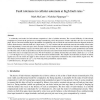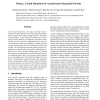10 search results - page 2 / 2 » Bounds on Non-surjective Cellular Automata |
ICS
2010
Tsinghua U.
14 years 4 months ago
2010
Tsinghua U.
Computation in the physical world is restricted by the following spatial locality constraint: In a single unit of time, information can only travel a bounded distance in space. A ...
JCSS
2008
13 years 7 months ago
2008
A commonly used model for fault-tolerant computation is that of cellular automata. The essential difficulty of fault-tolerant computation is present in the special case of simply ...
SASO
2008
IEEE
14 years 1 months ago
2008
IEEE
—When programming a spatial computing medium such as a cellular automaton, the hop count distance to some set of sources (particles) is an often used information. In particular, ...
ATS
2000
IEEE
13 years 12 months ago
2000
IEEE
At very high frequencies, the major potential of asynchronous circuits is absence of clock skew and, through that, better exploitation of relative timing relations. This paper pre...
JCST
2007
13 years 7 months ago
2007
Abstract Advances in wireless sensor networks and positioning technologies enable new applications monitoring moving objects. Some of these applications, such as traffic managemen...


